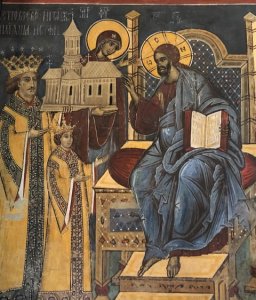Presented By: Medieval and Early Modern Studies (MEMS)
Medieval Lunch. Architectural Representations in Late Medieval Donor Portraits
Alice Isabella Sullivan, History of Art

Votive images of donors holding an architectural model appear in a variety of media spanning the entire Middle Ages. Although related to western European examples (examined by E. S. Klinkenberg in Compressed Meanings 2009, among others), the church models in late medieval votive paintings in the Byzantine-Slavic cultural spheres offer new insights into the multiplicity of meanings and functions of such architectural representations.
This talk focuses on several case studies from regions of the Balkans and the Carpathians that reveal the varied systems of signification of church models as they appear in votive murals, usually located in the naos of churches. These images show facets of the actual structures and the processes of decoration of the edifices. For example, in the Moldavian context, the church model is never shown with the rich exterior mural cycles that cover entirely the exterior of the churches. Instead, the focus is on select architectural features and the symbolic functions of the edifice in its representational form.
In examining the iconographic details of these image types, and in considering the multitude of their meanings and functions in their specific contexts of display, I argue that such architectural representations were carefully calibrated to give visual expression to local concerns related to patronage, salvation, and memory, as well as, on a larger scale, to the formation of new sacred landscapes in Eastern Europe for which Orthodox Christianity with its rich spatial and visual manifestations served as a defining force in the later medieval period.
This talk focuses on several case studies from regions of the Balkans and the Carpathians that reveal the varied systems of signification of church models as they appear in votive murals, usually located in the naos of churches. These images show facets of the actual structures and the processes of decoration of the edifices. For example, in the Moldavian context, the church model is never shown with the rich exterior mural cycles that cover entirely the exterior of the churches. Instead, the focus is on select architectural features and the symbolic functions of the edifice in its representational form.
In examining the iconographic details of these image types, and in considering the multitude of their meanings and functions in their specific contexts of display, I argue that such architectural representations were carefully calibrated to give visual expression to local concerns related to patronage, salvation, and memory, as well as, on a larger scale, to the formation of new sacred landscapes in Eastern Europe for which Orthodox Christianity with its rich spatial and visual manifestations served as a defining force in the later medieval period.